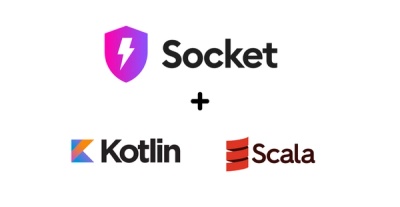
Product
Introducing Scala and Kotlin Support in Socket
Socket now supports Scala and Kotlin, bringing AI-powered threat detection to JVM projects with easy manifest generation and fast, accurate scans.
github.com/edwindvinas/goquery
goquery brings a syntax and a set of features similar to jQuery to the Go language. It is based on Go's net/html package and the CSS Selector library cascadia. Since the net/html parser returns nodes, and not a full-featured DOM tree, jQuery's stateful manipulation functions (like height(), css(), detach()) have been left off.
Also, because the net/html parser requires UTF-8 encoding, so does goquery: it is the caller's responsibility to ensure that the source document provides UTF-8 encoded HTML. See the wiki for various options to do this.
Syntax-wise, it is as close as possible to jQuery, with the same function names when possible, and that warm and fuzzy chainable interface. jQuery being the ultra-popular library that it is, I felt that writing a similar HTML-manipulating library was better to follow its API than to start anew (in the same spirit as Go's fmt package), even though some of its methods are less than intuitive (looking at you, index()...).
Please note that because of the net/html dependency, goquery requires Go1.1+.
$ go get github.com/PuerkitoBio/goquery
(optional) To run unit tests:
$ cd $GOPATH/src/github.com/PuerkitoBio/goquery
$ go test
(optional) To run benchmarks (warning: it runs for a few minutes):
$ cd $GOPATH/src/github.com/PuerkitoBio/goquery
$ go test -bench=".*"
Note that goquery's API is now stable, and will not break.
AttrOr helper method to return the attribute's value or a default value if absent. Thanks to piotrkowalczuk.*Matcher functions, that receive compiled cascadia selectors instead of selector strings, thus avoiding potential panics thrown by goquery via cascadia.MustCompile calls. This results in better performance (selectors can be compiled once and reused) and more idiomatic error handling (you can handle cascadia's compilation errors, instead of recovering from panics, which had been bugging me for a long time). Note that the actual type expected is a Matcher interface, that cascadia.Selector implements. Other matcher implementations could be used.html.Nodes.NewDocumentFromReader() (thanks jweir) which allows creating a goquery document from an io.Reader.NewDocumentFromResponse() (thanks assassingj) which allows creating a goquery document from an http response.EachWithBreak() which allows to break out of an Each() loop by returning false. This function was added instead of changing the existing Each() to avoid breaking compatibility.Document.Root is removed, Document is now a Selection itself (a selection of one, the root element, just like Document.Root was before). Add jQuery's Closest() method.goquery exposes two structs, Document and Selection, and the Matcher interface. Unlike jQuery, which is loaded as part of a DOM document, and thus acts on its containing document, goquery doesn't know which HTML document to act upon. So it needs to be told, and that's what the Document type is for. It holds the root document node as the initial Selection value to manipulate.
jQuery often has many variants for the same function (no argument, a selector string argument, a jQuery object argument, a DOM element argument, ...). Instead of exposing the same features in goquery as a single method with variadic empty interface arguments, statically-typed signatures are used following this naming convention:
Prev()), and the version with a selector string argument is called XxxFiltered() (e.g.: PrevFiltered())Is())XxxSelection() and take a *Selection object as argument (e.g.: FilterSelection())XxxNodes() and take a variadic argument of type *html.Node (e.g.: FilterNodes())XxxFunction() and take a function as argument (e.g.: FilterFunction())Matcher interface and are defined as XxxMatcher() (e.g.: IsMatcher())The complete godoc reference documentation can be found here.
Please note that Cascadia's selectors do not necessarily match all supported selectors of jQuery (Sizzle). See the cascadia project for details.
See some tips and tricks in the wiki.
Taken (and adapted as if executed from outside the goquery package) from example_test.go:
package main
import (
"fmt"
"log"
"github.com/PuerkitoBio/goquery"
)
func ExampleScrape() {
doc, err := goquery.NewDocument("http://metalsucks.net")
if err != nil {
log.Fatal(err)
}
doc.Find(".reviews-wrap article .review-rhs").Each(func(i int, s *goquery.Selection) {
band := s.Find("h3").Text()
title := s.Find("i").Text()
fmt.Printf("Review %d: %s - %s\n", i, band, title)
})
}
func main() {
ExampleScrape()
}
The BSD 3-Clause license, the same as the Go language. Cascadia's license is here.
FAQs
Unknown package
Did you know?

Socket for GitHub automatically highlights issues in each pull request and monitors the health of all your open source dependencies. Discover the contents of your packages and block harmful activity before you install or update your dependencies.

Product
Socket now supports Scala and Kotlin, bringing AI-powered threat detection to JVM projects with easy manifest generation and fast, accurate scans.

Application Security
/Security News
Socket CEO Feross Aboukhadijeh and a16z partner Joel de la Garza discuss vibe coding, AI-driven software development, and how the rise of LLMs, despite their risks, still points toward a more secure and innovative future.

Research
/Security News
Threat actors hijacked Toptal’s GitHub org, publishing npm packages with malicious payloads that steal tokens and attempt to wipe victim systems.